Résumés
Abstract
“Art as a way of knowledge” examines ways in which themes of spiritual development and ultimate transformation can be expressed through movement. The discussion follows the artist through the phases of creation of a dance video, Animus, and offers a Jungian interpretation of the piece. Animus looks at one woman’s journey of spiritual transformation. It shows a central female character (the anima), moving in and out of relationship with three male characters, two human and one animal, who represent her masculine side, or animus. Moving through a dreamscape of her own unconscious, she begins to interact more consciously with her masculine side and eventually comes to terms with it. Ultimately, she overcomes fragmentation and integrates male and female, spirit and body in the composite symbol of the Self at the end.
Résumé
Cet article examine les voies par lesquelles certaines formes de développement spirituel et de transformation ultime peuvent être exprimées par le mouvement. Cette présentation suit l’artiste à travers les différentes phases de la création d’une vidéo de danse, Animus, sous l’angle d’une interprétation jungienne de cette oeuvre. Animus est un regard porté sur le voyage vers la transformation spirituelle d’une femme. Il montre un personnage féminin principal (l’anima) en une relation alternée avec trois personnages mâles, deux humains et un animal, qui représentent son côté masculin, ou animus. Se déplaçant à travers le paysage rêvé de son propre inconscient, elle entre plus consciemment en interaction avec son côté masculin et finit par pactiser avec lui. De manière ultime, elle surmonte la fragmentation en intégrant les aspects masculin et féminin, spirituel et corporel, dans la composition symbolique du Soi.
Corps de l’article
In the summer of 2001, I choreographed and directed a video which highlights the connections between dance and spirituality. This work was a natural development of my interest in dance, the experimental work I did with my Svaha Movement Theatre group, my direction of the St. John’s College Liturgical Dancers, and a course on Religion and Dance, which I developed for the University of Manitoba as part of their Innovation series in 2000. Although intended as a site-specific work which would interact with the Manitoba landscape, as the work progressed, it took on its own momentum and the results exceeded my choreographic expectations. The following discussion, which is part photographic essay, part case study and part autobiographical account traces the creation and interpretation of the video, Animus. It explores how movement can be used as a vehicle for self-understanding and transformation.
The paper integrates two different perspectives on dance: that of the creative artist, who produces the piece, and that of the scholar, who is able to step back and analyse the work once it is completed. The skills required to create the dance video are radically different from those required for scholarly analysis. The first involves the physical manipulation of bodies in three-dimensional space to create visual sequences of non-verbal movement. This part of the process relies on kinaesthetic awareness, improvisation and aesthetic concerns and is an intensely personal experience. This is reflected in the choice of language. When speaking with the voice of the artist, the first person “I” is used. Scholarly analysis, on the other hand, requires one to be able to discuss the material objectively. In this case, separation from the work is essential. When the discussion moves to analysis of symbol and narrative, the language shifts as well. When speaking in the voice of the writer/scholar, I refer to the female dancer in the video in the third person, as “she.” Writing in these two voices is not without difficulties, but it also generates new possibilities for understanding dance. The reader may be able to gain a clearer understanding of the process of artistic creation and secondly, to be introduced to one method of reading dance.
Briefly stated, Animus follows one woman on a journey of spiritual transformation. It shows a central female character (the anima), moving in and out of relationship with three male characters, two human and one animal, who represent her masculine side or animus. Moving through a dreamscape of her own unconscious, she begins to interact more consciously with her masculine side and eventually comes to terms with it. Ultimately, she overcomes fragmentation and integrates male and female, spirit and body in the composite symbol of the Self at the end.
Many of the themes in the video contain striking parallels to the theories of Carl Jung, and his ideas and terminology provide a framework for understanding. Swiss pschologist and psychiatrist, Carl Gustav Jung (1875-1961) was the foremost disciple of Sigmund Freud until 1912 when Jung ended their association and set out his own theories of the psyche. Jung suggests that the unconscious contains a language, which is expressed through symbols in art and dreams. Symbols are the method that the unconscious uses to communicate important information and guidance to the conscious mind. Recognizing these images is part of the process of self-understanding, which according to Jung ultimately shifts the personality to a higher and more wholesome level of functioning. His ideas, featured in such works as Modern Man in Search of a Soul (1933) and Psychology and Religion (1938) have generated the Jungian school of analysis and have helped shape the field of psychology. Jung’s theory of the creative process, his terminology and his methodology for analysing the content of the video are introduced in this discussion to provide a context for interpretation and to demonstrate how artistic activity can be a path to heightened self-awareness.
The paper is divided into three major sections. Part One, “The Creative Process,” is written from an artist’s point of view and explains how the creative process unfolded. Insights from scholars working primarily in the fields of dance and performance studies, which corroborate my own experience and Jung’s views on creativity, are included. In the second section, the emphasis is on interpretation and analysis of the finished product. Part Two begins with the identification of key Jungian terms such as animus and shows how Jungian concepts may provide a useful interpretative context for the work. The third section includes images and a detailed narrative of the video, Animus. The conclusion charts the underlying structural and psycho-spiritual dynamic to help the reader see the dance video as a spiritual journey. Closing remarks direct the reader to other conceptually similar choreographies.
Part One: The Creative Process
There are many different ways to create choreography. Some, like George Balanchine, begin with a musical score and use the dancers to create musical visualizations on stage (Foster 1986: 14-22). Others may use a thematic approach. Canada’s James Kudelka is guided by a thematic exploration of Elizabeth Kubler-Ross’ five stages of death and dying in his classic work, In Paradisium (McPherson 2000: 288). Martha Graham’s dances are often psychological studies of depth experiences, that spring from psychoanalysis (Siegel 2001: 310). Merce Cunningham’s work is divorced from story line, characterization, musical and psychological interpretation. For him, movement is an independent entity. Dance is only about dance (Murray 1979: 68-99).
In addition to these mainstream approaches, it is also possible to create choreography through experimentation and improvisation. In this case, the artist does not try to create movements to illustrate a particular theme or tone and does not have a narrative or set score in place. Instead, the artist allows the work to evolve naturally and without premeditation. By remaining open, experimenting and allowing new movements to surface, a work guided by its own inherent storyline, emotion and logic can emerge. This was my experience.
The creative choreographic process for the video, which lasted about three months, began with improvised movements. These were later isolated and modified. This part of the process relied on intuition, physical impulses and a desire to let the experience generate its own aesthetic integrity, coherence and “truth. ” Over time, the work was shaped and refined in the studio. After the raw footage was captured on digital tape, I worked with a video editor to try to translate the bodily experience, or what Kalpana Ram calls the “flesh effort of understanding, ” (2000: 1) into visual form. Finally, music was added. Like the movements themselves, the sound track was created through improvisation and later mixed with the assistance of a sound engineer.
In retrospect, I can identify three features that characterized the creative process: 1) it was guided by intuition; 2) it had a playful component, and 3) it generated its own structures.
Intuition
I did not begin with a score, narrative or specific set of steps. The key was simply to remain open to the artistic process. Creativity is highly individual and cannot be forced. It can however, be facilitated by an attitude of intuition, receptivity and non-interference, which allows images and physical impulses to come to the surface.
Rehearsals were an opportunity to play with ideas and to try out new things. There was no set agenda, and movements were spontaneous. Sessions, especially those in the beginning, were exploratory and non-critical. The structure of these practice sessions was deliberately loose and pliable so as to allow gestures to develop on their own. At this stage, I was constantly improvising and innovating, which freed me from any sense of rule-bound formalism and convention. The effect was antistructural and even antichoreographic (Carter 2000: 181). As dance historian and critic Sally Banes explains
...it (improvisation) stands in direct opposition to choreography. So in a way, improvisation is very subversive. And in that subversive role improvisation has its purest sense, improvisation really does away with all the conventions that we know, that we recognize a dance work by.
(cited in Foster 2001: 28)
Although the language is more overtly religious, Ruth St. Denis may have been suggesting something similar. When the American dancer began to create a new piece, after a period of relaxation and meditation, she would try to become an “impersonal instrument of spiritual revelation” (LaMothe 2001: 64; Miller 1997: 134). Similarly, dance critic Curtis Carter explains that all improvisation-based choreographies rely on the intuitive resources of the mind and the ability to invent new forms spontaneously (2000: 181-182). Like Carter, I recognized the linkages between improvisation and intuition.
Jung speaks of the artist as one who “allows art to realize its purpose through him” (Jung 1971: 203). This process, which allows the art to surface, is intuitive rather than cognitive. Jung suggests that during creation “we neither see nor understand” (Jung 1971: 195). In fact, at this point, cognitive processes are actually “disruptive” and “injurious to immediate experience” (Jung 1971: 195).
Playfulness
At times we would become so immersed in this so-called play of the dance that everything came together seamlessly, and I experienced glimpses of what might be defined as “flow. ”
According to Csikszentmihalyi this is
...the merging of action and awareness. A person in flow has no dualistic perspective: he is aware of his actions but not the awareness itself. The steps for experiencing flow... involve the process of delimiting reality, controlling some aspect of it, and responding to the feedback with a concentration that excludes anything else as irrelevant.
(1975: 53-54)
Jung also regards play as an integral part of the creative process. For him, play is the dynamic principle of the imagination, which drives all creative work. He writes, “The creation of something new is not accomplished by the intellect, but by the play instinct acting from inner necessity. The creative mind plays with the objects it loves” (1971:200). Both play and improvisation are free from criticism and judgments of right and wrong. Play allows the individual the freedom to experiment with a large number of possible combinations and outcomes.
Self-generating structure
During rehearsal, certain sequences of movement emerged as more powerful. Gradually, through a process of elimination, a core set of elements emerged. These were later refined, and in general, simplified. Eventually, the revised sequences became the building blocks of the choreography, which were then set, rehearsed and documented.
It may seem remarkable that a work created through experimentation and improvisation should generate a coherent narrative and theme with clearly defined characters, but it did. Jung would not find this unusual. He sees art as growing organically out of the unconscious, “as a child from its mother,” and containing innate patterns that can only be recognized at the end (1971: 203). He explains, “out of a playful movement of elements whose interrelations are not immediately apparent, patterns arise which an observant and critical intellect can evaluate afterwards” (1971: 200). Jung would go so far as to suggest that the artistic creation is independent of the artist. The artist is simply a “helpless observer of events” (1971: 197), an “instrument for his/her art” and “subordinate to it” (1971: 203). The work creates itself, and the role of the artist is to allow this process to be actualised by “elaborating and shaping this image into the finished work” (1971: 203).
Part Two: Animus — Interpretative Context
The creative aspect of the video entailed flow, intuition and the suspension of preconceived structures. The iterative process of discussion and interpretation required analytical skills. It was a completely separate kind of process, but gradually, the mute language of corporality and gesture became articulated as discourse and the internal structure of the work revealed itself. Jung also recognizes that the creation and articulation of art are two separate activities. One must detach oneself from the work and look at it from the outside in order to perceive its meaning (Jung 1971: 195).
Since the video contains parallels to some of the major themes in Jungian psychology, (anima, animus, shadow, Self) Jung’s terminology and method of analysis are introduced below.
Anima/animus
Jungian psychology suggests that human beings contain unconscious forces of male (animus) and female (anima), which must be consciously reconciled in order to gain mature and optimal psychospiritual health (Jung 1964: 17). From a woman’s perspective, it is important that she comes to terms with her own masculine side, the animus, and integrate its courage, initiative and preservation into her own personality (Bertine 1967: 137). The animus represents the principle of masculinity and may be personified through a variety of different expressions. In the video, all males, including the shadow/minotaur are successive expressions or various facets of the animus. Every interaction with a male awakens the woman to new possibilities and heightened self-awareness. In the end, the woman is able to blend the anima/animus into a new symbol of wholeness and transformed awareness, the Self.
The Shadow
In Jungian thought, the process of individuation, or the “conscious coming to terms with one’s Self” (Von Franz 1964: 169) often begins with the appearance of a shadow figure in dreams. The shadow, which appears differently to each person, represents the most repressed and neglected side of one’s personality. The first encounter with unresolved and unconscious issues can be uncomfortable and even frightening to an individual. The shadow is not evil, but simply a catalyst for change. But sometimes, change can be painful. Jung writes:
The shadow is a tight passage, a narrow door, whose painful construction no one is spared who goes down to the deep well. But one must learn to know oneself in order to know who one is.
(1971: 243)
When an individual is able to face one’s shadow and to come to terms with it, by means of compassion, charity, altruism and the light of consciousness, then one is able to integrate the hidden and secret powers of the unconscious. When recognized and integrated, the shadow becomes a source of great inner strength and self-knowledge. Jung refers to the integrated shadow as “the healing serpent of the mysteries,” (1971: 243) because it contains such valuable vital forces and transforming powers of growth.
In the video, the shadow takes the form of a minotaur, which represents the untamed, raw, primordial animal instincts of the male. The shadow first makes its appearance at the beginning of the video, stimulating the process of psychospiritual growth. Two-thirds of the way through the video, the shadow comes closer, making a longer and more ominous appearance. The audience glimpses the shadow’s primal fleshiness. When the shadow emerges from the darkness and appears, roaring in broad daylight at the woman, they meet face to face. Gently, calmly and without fear, the woman dances with the minotaur, soothing him and mastering his animal nature. Jungian psychologist Joseph Henderson uses the myth of beauty and the beast to show the positive effects when a woman accepts and humanizes this side of existence:
By learning to love Beast, she awakens the power of human love concealed in its animal (and therefore imperfect), but genuinely erotic form. Presumably, this represents an awakening of her true function of relatedness, enabling her to accept the erotic component… In this way, she redeems herself and her image of the masculine from the forces of repression, bringing to consciousness her capacity to trust her love as something that combines spirit and nature in the best sense of the words.
(1964: 131)
In the video, it is only after the woman confronts the shadow of the minotaur in daylight, or in Jungian terms, consciously, that she gains complete control over it. Once she recognizes and accepts it, the shadow/minotaur becomes her willing servant and places his head in her lap in a gesture of submission and affection. No longer a potential threat, the animus becomes a secure ally.
The Self
The final shot at the end of the video shows a woman, standing alone, wearing the mask of the minotaur. This new, composite form, embodies both anima and animus in a symbol of the transformed or individuated Self. As a symbol of psychological wholeness and health, the Self is represented as male and female, animal and human, in the liminal region of twilight where darkness and light, conscious and unconscious merge. Opposites are no longer at war, but are reconciled into a significant whole (Bertine 1967: 50). For Jung, this represents the highest state of human functioning, wholeness, where the rejected and dark elements of the personality have been reconciled and embraced
Part Three: Animus — Video Narrative
The performers I worked with had diverse backgrounds. Trained in Canada and in Brazil, James Ash is an instructor in capoeira, a type of movement involving martial arts and dance, which was developed in South America by African slaves (Albright 2001: 43-44). Shawn Gromniski, a member of my Movement Theatre troupe, has a background in karate, and Michael Olito is an internationally recognized actor, visual and performance artist. My own background includes training in dance therapy as well as ballet, modern, Flamenco, African and Middle-Eastern dance styles.
Figure 1
The shadow appears
First Movment: Sleeping
The video is divided into five movements. The first movement begins with a premonition, represented by the shadow, that is used to convey unconscious animal instincts. This fades out to a scene of a woman asleep on the floor, who represents the dormant and unawakened anima. She is wearing a violet-coloured ball gown, the colour associated with sublimated passions and the desire for mystical union. Suddenly a male dancer, the first personification of the animus sits up behind her. He looks around and begins to do a series of capoeira back flips and handstands around her, but she remains deep in sleep and unaware of his presence. She stirs once, only to draw herself into fetal position. Slowly, he approaches, gently touches her shoulder and lies down beside her. Her eyes are still closed as the two dancers begin to move in an ebb and flow of soft rolling movement on the floor. Still with eyes closed, the two begin to move in unison, each synchronized with the other, half-sitting at times, now outstretched and elongated, now curling back into the fetal position. Compared to the acrobatic moves of the male in the opening scene, the gestures are now slow and organic like a flower opening and closing its petals. The female has been stimulated by the male, even if her response remains unconscious at this time, while the male has absorbed some of the grace and restraint of the female.
The lighting of this and the following sequence is important. Set against a static black background and floor and lit with a combination of purple and gold lights, the performers appear to move in space without boundaries. It creates a dream-like atmosphere representative of the unconscious, where images arise and dissolve amorphously.
The two eventually move to a standing position with the female behind the male. She bends over him, holding her arms around him as if she is sheltering him with her wings. She does not make physical contact with him, but their arms move in unison. As the woman steps out of the scene, the male sinks back to the floor, opens his arms wide to express the purity of his intentions and then curls up into a tight prayer posture, returning to the earth. His eyes are shut and his hands cover his face.
Figure 2
The animus appears in darkness.
Figure 3
Sheltering arms.
The first personification of the animus is able to awaken something indefinable in the woman that remains below the level of consciousness. There is an instinctual response at some level, as indicated by the synchronized movements, but the woman chooses to leave the moment unrealised. The energy of the male is dormant as the first movement ends.
Second Movement: Awakening
The second male performer begins exactly in the same prayer posture, and another sequence of interaction between male and female begins. Slowly, he begins to uncurl, rolling his head from side to side, his hands still covering his eyes. This time it is the woman who touches the man’s shoulder and gently he turns to her and uncovers his face. Only then does the audience realize it is another dancer, or another expression of the animus. The covering and uncovering of the eyes indicates a transition from inside to outside, from unconscious to conscious, from one persona to another.
Figure 4
The second expression of the animus appears.
Figure 5
A conscious connection begins to grow
This time the couple is standing, and although they do not touch, they respond to each other’s gestures. First the woman leads, then the man. The couple begins to open up more and more to each other. The movements become larger and the woman, in particular, becomes more expressive, turning in a series of circles, which represents the desire for inner unity and the ultimate state of Oneness. She circles once more and floats to the floor, her dress whirling around her in a violet swathe. The male follows and sits down close behind her. At this point, the only point of physical contact was at the beginning of the movement when she touched his shoulder. Since then she has kept her distance so as to remain untouched herself.
Fluidly, the two begin to move their arms in opposition to create the effect of a multiple-headed, multiple-armed being. This suggests both unity in being and multiplicity in action. In Jungian terms, the anima and animus are naturally attracted to each other and seek unity; yet, at the same time they maintain their distinctive characteristics. The dialogue between anima and animus continues through the use of stylised hand gestures. They shape their hands into “ducks” and proceed to “talk” and nip playfully at each other. The motion then changes to a moving crown of fingers placed above the female’s head, to indicate graceful thoughts and a growing conscious, and perhaps intellectual connection with the other. Then, for the first time, the movement begins to show direct physical contact. Gently, the man wraps his arms around her from behind, enfolding her like a bird or a butterfly, and the couple bend forward and come to rest. Eyes and faces are hidden, as the holding is a silent, non-discursive experience. The point of contact now becomes the centre of the body and the second movement ends with the embrace.
Figure 6
The embrace
Third Movement: Seeking
The third movement shifts to a clearing deep inside a copse of trees in midsummer. This affects a transfer from the dark, unbounded, timeless world of the unconscious as suggested by the studio space, into the more natural light of nature/consciousness. It is an important transition in the evolution towards conscious understanding. The space is not yet that of the open, prairie vistas, which represent the ability to see clearly in all directions. Instead, it is a small green protected womblike nurturing space where growth continues. Within the copse, a canopy of branches encloses the couple and dapples of light illuminate the scene with chiaroscuro. This contrast of light and shadow is carried into their bodies as well. She is very fair, and he is dark. The couple is seated on the earth in the same embracing gesture. Lingeringly, they unfold their arms and gently they straighten their backs until they come to a seated, upright posture.
From there they begin to move their arms in unison from side to side like coral in the waves. Their wavelike gestures give the appearance of a patterned union and replicate the arches of the surrounding trees. The woman’s hands never touch her own body, but her partner’s hands move closer to her. The couple rise, the male standing behind the female, and they repeat the sequence. She drops her head, covers her eyes and slowly moves her head from side to side, imitating the earlier gesture of the male. It is as if she is disturbed and trying to hide from the awakening, which by its very nature is painful. The male recognizes her sorrow and empathizes with her, as he places his hands on hers and moves with her as she rolls her head.
Figure 7
Inside the copse
Figure 8
The pain of awakening
Finally, the woman looks up and gazes into the distance. She holds out her hand to her partner and begins to walk deeper into the dark underbrush. When the edge of the clearing is in sight, she lets go of his hand and he falls to earth lifeless. He cannot accompany her further. The woman does not appear concerned and does not even pause or look back. The separation is like a leaf dropping off a tree. The relationship has gone through its natural cycle of growth and maturation and it ends of its own accord. The male symbolizes a spiritual energy, or lesson, that her psyche must learn. From here, she must proceed on her own. As the third movement ends, we see the woman with her back to the camera, standing strong and erect and looking into the future. The audience catches a glimpse of a brighter, more expansive vista ahead.
Fourth Movement: Integrating
Suddenly, the music changes and the entire screen darkens with the shadow of the minotaur once again. This time, however, it is not a static shot as it is at the beginning, but a moving one. The shadow becomes larger and larger as the minotaur moves closer and the viewer sees just a bit of a body cloaked in animal skin. But it is enough to shift the scene. What was a shadowy premonition at the opening of the piece has turned into reality. Its relation to the woman at this point is unknown, and since the image of the minotaur is mythic, only partially visible and ambiguous, its presence is dramatic and unsettling.
Figure 9
The Shadow revealed in direct confrontation
In the following scene we see the woman standing in a sunny, open field, picking berries from a bush. She appears in a vulnerable position, with no protection. A close-up of her hands reveals she is picking small, red, poison berries. The tension of the scene is heightened when the audience is able to see the minotaur advancing from behind, while the woman remains unaware of its presence. The animal lets out a series of roars, and as the woman turns to look, he begins to advance, making threatening gestures. Shocked, but not afraid, the woman stands staring at him. The berries fall from her hand. After he leaves, she resumes her berry picking. The minotaur returns; still behind her, he silently places a hand on her shoulder. She turns and looks at him. Something unspoken is communicated between them, and she drops the berries and follows him. What the woman does not realize is that the minotaur’s appearance saved her from poisoning herself with the tantalizing berries, the symbol of small, apparently insignificant experiences, which may have lethal effects on the personality.
With slow, deliberate steps she follows her animus to the edge of the woods where he kneels in front of her. She places her hands on his forehead and her touch makes him tremble. At this point, there is a transference of power between them; woman and animal share a vital connection.
Figure 10
Submission
Image 11
At rest
Fifth Movement: Knowing
The minotaur kneels submissively, no longer merely allowing, but now welcoming the transforming touch of the female. He is visibly shaken, even electrified by the experience. More subtly, the woman is also changed as she absorbs some of his physical, animal, and masculine energies.
He rises and the two begin a duet in which the male challenges and advances, but the woman remains calm and eventually forces him to retreat docilely into the forest. In the next scene, the woman is sitting with the minotaur’s head on her lap. Soothingly, she strokes his head and he is quiet and subdued in her arms.
Time passes and she stands and places the minotaur’s head on the ground. As she does so, the audience sees that the minotaur has disappeared and all that remains are the skull and the animal skins that he wore. The animal side has been sacrificed as the woman has incorporated his power. What remains are the empty symbols of his presence. As she prepares to leave the woods forever, she turns for one last lingering look.
Figure 12
Transcendence
Finally, the woman is shown walking uphill through a verdant field of prairie grasses. The horizon opens before her and she appears to walk alone into the sky or heaven. She disappears and the camera sweeps the evening sky, coming to rest on a woman in silhouette. Slowly, she turns, wearing the mask of the minotaur. Against a background of sky, water and distant trees, she looks directly at the audience before the scene fades to black.
Conclusion
The following chart and summary comments explain the underlying structural dynamic of the video and make the linkages between the various components explicit to the reader.
Ultimately, Animus is a narrative of metamorphosis. The woman’s spiritual journey opens with her asleep in the first movement. This represents the beginning stage, when her self-awareness and energy remain dormant. Only a spotlight, which represents the germ of potential life, shines amidst the surrounding darkness. Without being fully aware, she begins to respond to the quickening presence of the male animus and proceeds to roll, curving and curling harmoniously to the rhythms of his body. Like the double helix of the human DNA and RNA, the couple replicate each other, and the dynamic of call and response is established between the couple, below the level of consciousness. Although not yet fully aware, she is nonetheless stimulated by the animus and begins to move on her own. Her intuition is also awakened and she begins to be aware that some indefinable process has now begun.
Table 1
Animus : Structural Dynamic
In the second movement, she is more consciously aware and awakens more fully to the male. Although still in darkness, the movements between the two are now more deliberate and interactive. They move as a couple, enfolding and holding each other with gestures of tenderness, their steps, postures and rhythms mirroring each other. This section is the first indication of genuine relationship and recognition of the other.
The third movement shifts the narrative from darkness to the secluded daylight of nascent awareness. In this setting, the woman begins a new phase. Like a child being born, she must move from the dark, comfortable world of unconscious physicality and seek her own independent existence. As she moves away from the animus, and he falls to the ground, she leaves her previous existence behind. Now, she understands herself as an independent entity, and is fully conscious of her need for continued growth.
In the fourth movement she is alone and forced to confront the darker and most perplexing aspect of her own personality (the shadow/minotaur). Although he casts an ominous shadow at first, when she meets him in daylight, she faces the minotaur without fear. Since he is no longer shrouded in darkness, she can interact with him confidently. In a slow dance of advance and retreat, she soothes the beast. At last, when he places his head in her lap, it indicates she has accepted and integrated her instinctual nature.
The final movement points towards spiritual knowledge and fulfilment. It takes place at sunset, which represents the final stage of human life and also the liminal state in which light and darkness are perfectly merged. The woman has now found her way and moved from darkness to midday to evening, from the cave to the woods to theexpanse of the sky, from safety to danger and back to safety. Although at first she sees fragmented parts of herself projected onto others, in the end she is integrated and made whole. She faces the obstacles and psychological powers of the unconscious, and seeks to understand and utilize their power. Through the process, she is transformed. This is represented in the last image when her head and the minotaur’s head are one. It represents the final stage of twilight, where the dichotomies of darkness/light, male/female, anima/animus, body/spirit, conscious/unconscious, dreaming/waking, rational and instinctual are transcended. Her initiation into the life of the spirit has led to a complete regeneration and the seeker has become the knower of truth. The final image is that of the Jungian integrated Self. It is complete and whole, and therefore embraces the conscious and unconscious, heart and head and all other opposites. “As the psyche of every individual, it contains human potentiality. It is both masculine and feminine” (Bertine 1967: 102).
Although the particular movements and images in the video are my own, conceptually the piece relates to the common trend of self-exploration in modern dance. Some of the most prominent American choreographers such as Doris Humphrey, Charles Weidman, Meredith Monk, Joseph Campbell’s wife Jean Erdman, and especially Martha Graham (Circe, Primitive Mysteries, Errand into the Maze) have envisioned dance as an exploration of an interior world. Their work also uses ambiguous dreamlike atmospheres, symbols, myth, ritual action and primal relationships to translate the drama of the inner world to the audience. Even though each choreographer’s work is highly individual and idiosyncratic, their motivations are similar — to bring the inner world to the outer world. Speaking of Meredith Monk’s work, Jamake Highwater writes,
Dance changes biology into a metaphor of the spiritual body in much the same way that poetry changes ordinary words into forms that allow meaning that words normally cannot convey. That is precisely what Meredith Monk does for an audience when she turns theatre into a reflection of our most inward selves.
(1992: 218)
There are many ways to express a person’s inner journey and Animus is but one example. Hopefully, this discussion may serve as a point of departure for others to see the process of creating dance, and the dance itself in the light of a spiritual process. Art can function as a way of knowledge.
Parties annexes
Note biographique
Brenda Cantelo
Brenda Cantelo détient un doctorat en études religieuses de l’Université du Manitoba. Elle est spécialiste de la religion et des arts, plus particulièrement de l’art et de l’architecture de l’Asie du Sud ainsi que de la danse dans la perspective des religions du monde. Elle a fondé, à Winnipeg, le Svaha Movement Theatre et le St John’s College Liturgical Dancers, dont elle est la directrice artistique. Animus (2002) est sa première vidéo de danse. Brenda Cantelo est actuellement professeure à l’Université du Manitoba.
Brenda Cantelo has a Ph.D. in Religion from the University of Manitoba. Her major focus is Religion and the arts, and she specializes in South Asian art and architecture, and dance from a world religions’ perspective. She is the founder and artistic director of the Svaha Movement Theatre and the St John’s College Liturgical Dancers in Winnipeg. Animus (2002) is her first dance video. Brenda Cantelo currently lectures at the University of Manitoba.
References
- Albright, Ann Cooper. 2001. “À Corps Ouverts: Changement et échange d’identités dans la Capoeria et le contact improvisation”. Protée 29 (2) : 39-49.
- Animus. 2002. Videocassette. Dir. Brenda Cantelo.
- Bertine, Eleanor. 1967. Jung’sContribution to Our Time. New York: C.G. Jung Foundation for Analytical Pscyhology.
- Carter, Curtis. 2000. “Improvisation in Dance.” Journal of Aesthetics and Art Criticism 58 (2): 181-191. Retrieved December 20, 2001 from Ebsco, No AN 3067532. http://ehostvgw12.epnet.com/ehost.asp?key=204.179.122.141_8000_779837261&site=ehost
- &return=y
- Csikszentmihalyi, Mihaly. 1975. Beyond Boredom and Anxiety. San Francisco: Jossey-Bass.
- Foster, Susan Leigh. 1986. Reading Dancing: Bodies and Subjects in Contemporary American Dance. Berkeley: University of California Press.
- ______. 2001. “Improviser L’autre: Spontanéité et structure dans la danse expérimentale contemporaine”. Protée 29 (2): 25-38.
- Henderson, Joseph. 1964. “Ancient Myths and Modern Man”. In Carl Jung et al., Man and His Symbols. New York, Dell Publishing: 95-156.
- Highwater, Jamake. 1996. Dance: Rituals of Experience. New York: Oxford University Press.
- Jung, Carl. 1971. C.G. Jung: Psychological Reflections: A New Anthology of His Writings 1905-1961, Jolande Jacobi (ed.). London: Routledge and Kegan Paul.
- ______et al. 1964. Man and His Symbols. New York: Dell Publishing.
- LaMothe, Kimerer. 2001. “Sacred Dance”. Dance Magazine 75 (12 ): 64-66. Retrieved December 20, 2001 from Ebsco No AN 5540998. http://ehostvgw12.epnet.com/ehost.asp?key=204.179. 122.141_8000_779837261&site=ehost&return=y
- McPherson, Susan. 2000. Encyclopedia of Theatre Dance in Canada. Toronto: Dance Collection Press.
- Miller, Kamae (ed.) 1997. Wisdom Comes Dancing: Selected Writings of Ruth St. Denis on Dance, Spirituality and the Body. Seattle: Peace Works.
- Murray, Jan. 1979. Dance Now. Markham, ON: Penguin Books.
- Ram, Kalpana. 2000. “Listening to the Call of Dance: Re-thinking Authenticity and Essentialism”. Australian Journal of Anthropology 11 (3): 356-365. Retrieved December 20, 2001 from Ebsco No AN 3762265. http://ehostvgw12.epnet.com/ehost.asp? key=204.179.122.141_ 8000_779837261&site=ehost&return=y
- Siegel, Marcia B. 2001. “The Harsh, Splendid Heroines of Martha Graham”. In Ann Dils and Ann Cooper Albright (eds.), Moving History/Dancing Cultures: A Dance History Reader. Middletown (Connecticut), Wesleyan University: 307-314.
- Von Franz, Marie-Louise. 1964. “The Process of Individuation”. In Carl Jung et al.,Man and His Symbols. New York, Dell Publishers: 157-254.
- Weeks, Janet. 2001. “Making Divine Dances”. Dance Magazine 75 (12): 62-66. Retrieved December 20, 2001 from Ebsco, No AN 5540986. http://ehostvgw12.epnet.com/ehost.asp?key= 204.179.122. 141_8000_779837261&site=ehost&return=y.
Liste des figures
Figure 1
The shadow appears
Figure 2
The animus appears in darkness.
Figure 3
Sheltering arms.
Figure 4
The second expression of the animus appears.
Figure 5
A conscious connection begins to grow
Figure 6
The embrace
Figure 7
Inside the copse
Figure 8
The pain of awakening
Figure 9
The Shadow revealed in direct confrontation
Figure 10
Submission
Image 11
At rest
Figure 12
Transcendence
Liste des tableaux
Table 1
Animus : Structural Dynamic




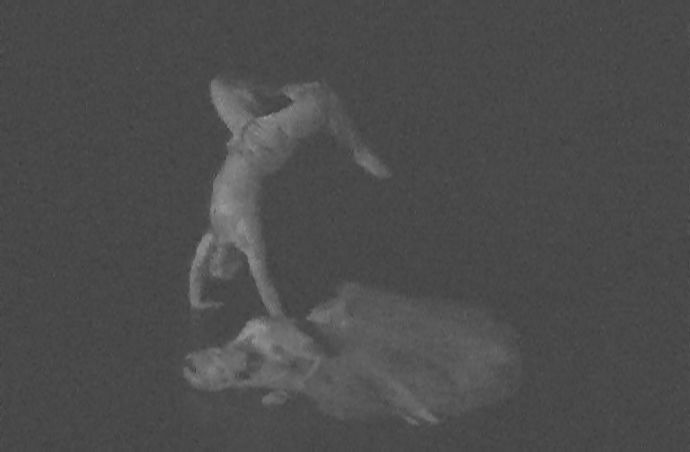
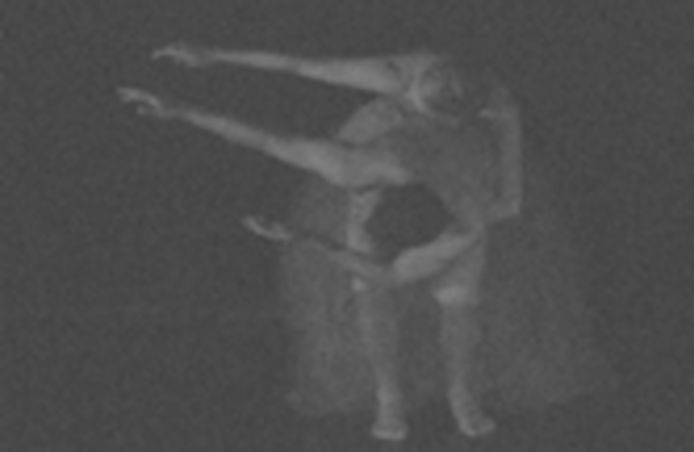
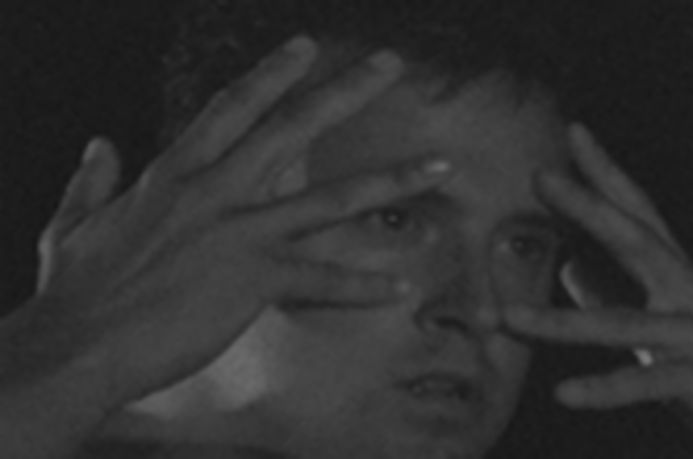

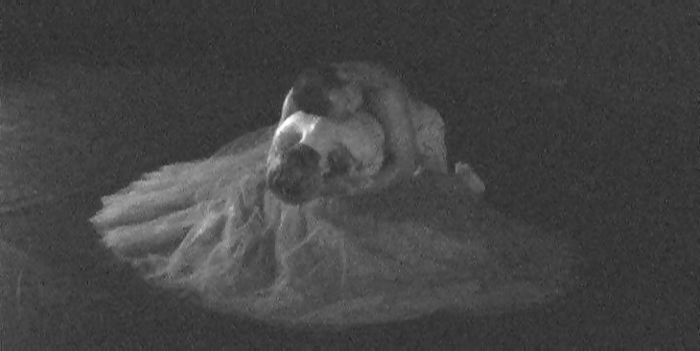


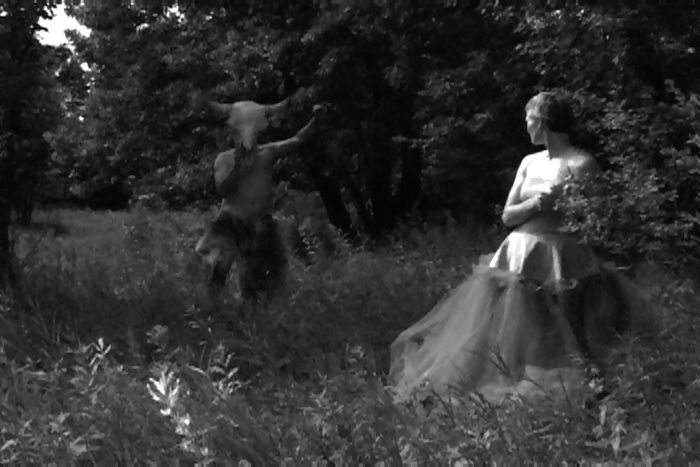
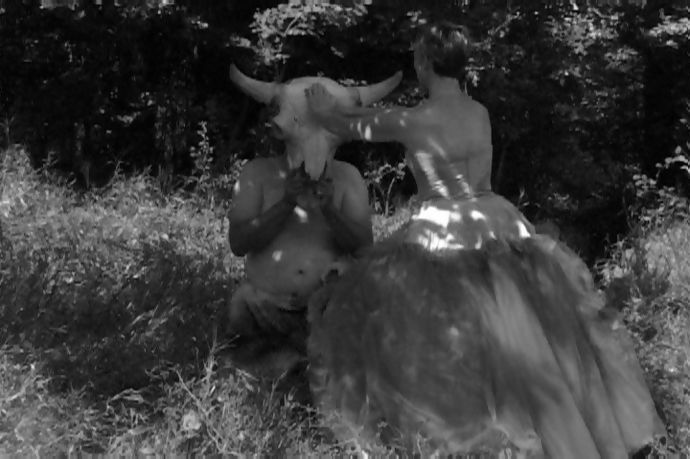
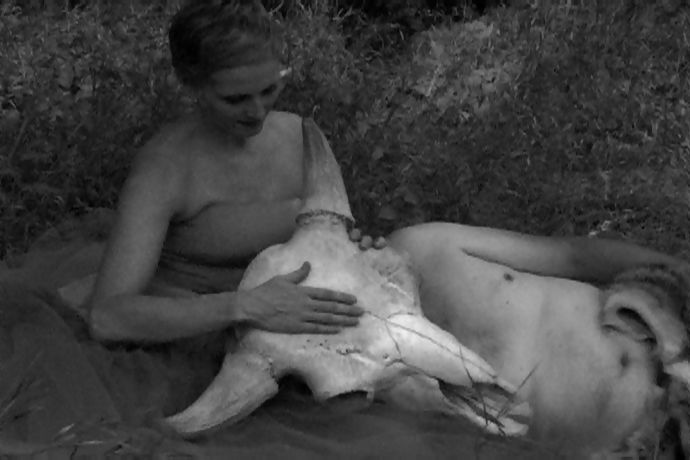

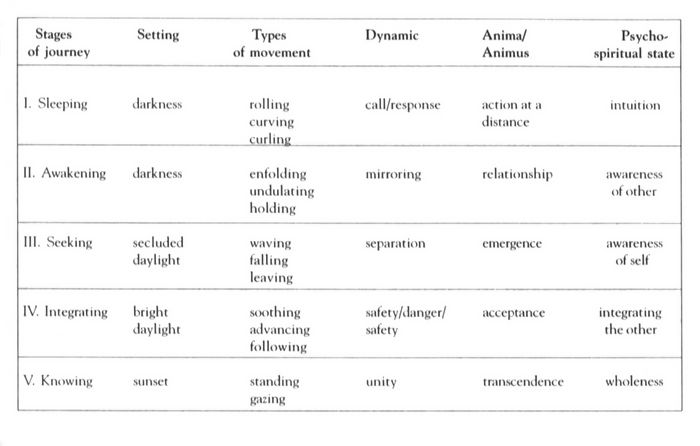
 10.7202/030624ar
10.7202/030624ar